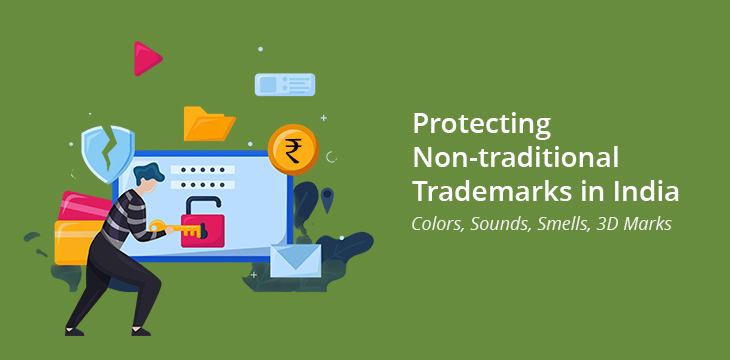Protecting Non-traditional Trademarks in India – Colors, Sounds, Smells, 3D Marks
Brand names, logos, and symbols have long been linked to trademarks. To differentiate their goods and services, firms are turning more and more to non-traditional trademarks like colors, sounds, fragrances, and 3D logos as the market gets more competitive and businesses change. Although the legal system in India permits the registration of such trademarks, there are particular restrictions and difficulties associated with the process.
Understanding Non-Traditional Trademarks
Non-traditional trademarks, also known as unconventional trademarks, are a fascinating evolution in the realm of intellectual property. These marks go beyond the conventional logos, names, and symbols to include elements like colors, sounds, smells, and 3D shapes. In India, the protection of such trademarks is still in its nascent stages, but it holds immense potential for businesses looking to create unique brand identities. Non-traditional trademarks go beyond conventional wordmarks and logos to include distinctive elements that contribute to a brand’s identity. These marks help businesses establish strong brand recall and differentiate their offerings in a crowded market. The most common types of non-traditional trademarks include:
Color Marks: A specific color or combination of colors that uniquely identifies a brand. For example, Cadbury’s purple and Tiffany’s blue are well-known color trademarks globally.
Sound Marks: A unique sound associated with a brand, such as the Intel startup chime or the MGM lion’s roar.
Smell Marks: A distinctive scent that consumers associate with a particular brand, such as the floral fragrance of a specific perfume.
Legal Framework for Non-Traditional Trademarks in India.
The Trade Marks Act, 1999 governs trademark registration in India, including non-traditional trademarks. However, proving the distinctiveness of these marks can be challenging. Unlike traditional trademarks, which rely on word or visual recognition, non-traditional trademarks must demonstrate that consumers associate them exclusively with the brand over time.
To successfully register a non-traditional trademark in India, businesses must fulfill certain legal requirements, including:
Distinctiveness: The mark must be uniquely associated with the brand and not commonly used in the industry.
Graphical Representation: The trademark must be capable of being represented graphically, which is particularly challenging for sound, smell, and certain 3D marks.
Acquired Secondary Meaning: Many non-traditional trademarks require proof that they have gained distinctiveness through long-term use and consumer recognition.
Registration Process for Non-Traditional Trademarks in India.
Conduct a Trademark Search: Before filing an application, a thorough search should be conducted to ensure the mark is not already registered or similar to an existing one.
File the Trademark Application: The application should be submitted to the Controller General of Patents, Designs, and Trademarks, including detailed descriptions and evidence of distinctiveness.
Examination Process: The trademark office examines the application to determine if the mark meets the legal requirements.
Publication in the Trademark Journal: If approved, the mark is published in the Trademark Journal for opposition.
Registration and Certification: If no opposition is filed within the prescribed period, the mark is registered, and the applicant receives a certificate of trademark registration.
Challenges in Protecting Non-Traditional Trademarks.
While non-traditional trademarks offer unique branding opportunities, their registration and enforcement come with several challenges:
Proving Distinctiveness: Unlike word or logo marks, non-traditional marks require extensive evidence to prove consumer association.
Graphical Representation Requirement: Sound marks require submission of a musical notation, smell marks need a written description, and 3D marks need precise visual representation.
Higher Likelihood of Objection: The Indian Trademark Office may raise objections based on non-distinctiveness or difficulty in representation.
Enforcement and Infringement Issues: Non-traditional trademarks are more difficult to enforce, especially if consumer recognition is not widespread.
Notable Non-Traditional Trademark Registrations in India
Several businesses have successfully registered non-traditional trademarks in India, setting precedents for future applicants:
Yahoo! Yodel (Sound Mark): Yahoo! became one of the first companies to register a sound trademark in India.
Nokia Tune (Sound Mark): Nokia’s iconic ringtone secured trademark protection.
Zippo Lighter Shape (3D Mark): The distinctive design of the Zippo lighter was granted protection.
Colgate’s Red and White Combination (Color Mark): Colgate obtained a trademark for its signature color scheme.
How Businesses Can Strengthen Their Non-Traditional Trademark Applications
To improve the chances of successful registration, businesses should:
Gather Strong Evidence of Use: Documenting long-term use and brand recognition can support claims of acquired distinctiveness.
Use Consumer Surveys: Conducting surveys to demonstrate public association with the mark strengthens the application.
Ensure Proper Representation: Accurately depicting sound, smell, color, or 3D marks according to trademark office guidelines can prevent objections.
International Perspective
India's approach to non-traditional trademarks is influenced by international agreements like the TRIPS Agreement (Trade-Related Aspects of Intellectual Property Rights). Countries like the United States and the European Union have more advanced frameworks for protecting non- traditional trademarks, providing valuable insights for India.
Future Prospects
The protection of non-traditional trademarks in India is expected to evolve as businesses increasingly adopt innovative branding strategies. To facilitate this, the following steps can be considered:
1. Amendments to the Trademarks Act: Introducing specific provisions for non-traditional trademarks can provide clarity and encourage their registration.
2. Awareness Campaigns: Educating businesses and legal professionals about the potential of non-traditional trademarks can drive their adoption.
3. Judicial Precedents: As more cases related to non-traditional trademarks are adjudicated, they will provide valuable guidance for future applicants.
Conclusion
As brands continue to innovate, non-traditional trademarks play an increasingly important role in brand differentiation and consumer recall. While the registration process in India involves unique challenges, businesses that successfully protect their color, sound, smell, and 3D trademarks can gain a significant competitive advantage.

